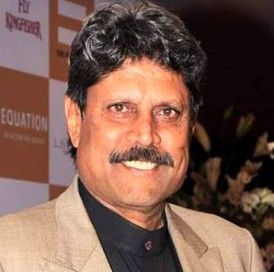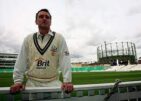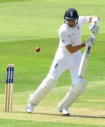Kapil Dev versus West Indies
Gareth Bland |
As Kapil Dev Ramlal Nikanj contemplated the third Test match in his country’s six match series against Pakistan in the summer of 1982/83, he might just have had one eye on the trials about to come after that. That third Test was scheduled to start on 3 January, the calender granting both teams sufficient breathing space to take in the New Year after the second Test in Karachi had finished on 27 December. Preoccupied as he was with Imran Khan at the top of his game and with Pakistani batsmen running amok, Kapil knew that a still deadlier foe lay in wait after hostilities with Pakistani had ended.
In the February of 1983 Kapil was to board the team’s jet as captain and fly to the Caribbean to take on the West Indies in a full five Test series. If that were not enough, there were to be renewed hostilities in the Indian home summer later that year, when both teams would battle it out in a six Test series. Sandwiched between these two mammoth series was the 1983 World Cup in England. Once again, West Indies lay in wait, slotted for two group games in the tournament’s early stages. If India were lucky – and, who knows, anything could happen in a cup competition – India could potentially meet Lloyd’s team again later in the tournament.
So as Kapil plotted a way of thwarting the Renaissance Man from Lahore in a few days time, he also knew tough times would dog his every footstep for the following 12 months of international cricket. Just how tough, and how dramatic, he could never have envisaged, for not only would he surmount those challenges head on as his country’s premier strike bowler and all-rounder, he would also carry out his duties with the added burden of captaincy, following Sunil Gavaskar’s replacement after the series defeat in Pakistan. Kapil’s 1983 was, then, the ultimate year in his Test match career.
In terms of his three great all-round contemporaries: Imran Khan, Richard Hadlee and Ian Botham, it arguably surpasses, for genuine arduousness, anything that Imran and Hadlee were ever subjected to, certainly in terms of their career against the West Indians. Botham had his 1980/81, of course, where he played 9 Tests against West Indies home and away, including the trauma which came as a result of Ken Barrington’s death in Barbados early in 1981. Kapil, like Botham, was unexpectedly saddled with the captaincy at the age of 24 and with back to back series against the world’s best as his first challenge. So, to ultimately judge Kapil against the strongest team of his era it is necessary to begin with that most fabled year in India’s cricket history: 1983.
The thing is, 1983 was not quite the beginning for Kapil and the Windies. They had first become acquainted in the subcontinent in 1978/79 during the second winter of the Packer era. India, unaffected by Packer defections, were at full strength against a West Indies line up led by Alvin Kallicharran. Although the West Indians fielded teams which included Sylvester Clarke and a 20 year old Bajan rookie called Malcolm Marshall, the six Test series can hardly be said to represent the best of the Caribbean at that time. Indeed, the world beating force in its then embryonic form was assembled en masse Down Under at the same time. Nevertheless, Kapil made a splendid start against Kallicharran’s team. Making his Test bow aged 19, he made 329 runs in seven innings, playing throughout the series. His top score of 126 not out in the fifth Test in Dehli was made as part of a huge Indian first innings total of 566/8. Although Marshall appeared fitfully, and was clearly not yet the force he would go on to become, West Indies regularly operated with Clarke, Vanburn Holder and Norbert Phillip as their strike force. Marshall took just three wickets in three Tests, while Sylvester Clarke topped the Windies bowling averages with 33 wickets at 33.85.
With the ball, Kapil was steady, claiming 17 wickets in the six Tests at an average of 33 on surfaces concocted to suit the batting side. Gavaskar, Viswanath and Vengsarker all compiled in excess of 400 runs in the series, with Sunny amassing a colossal 732 in just nine innings. In circumstances which were similar to those of England’s tour of India in 1981/82, the series produced five draws, with India taking the rubber by a Test to nil. Additionally, only five of the West Indies squad had international experience prior to the lengthy sojourn in the subcontinent. All in all this was a good start to the young Haryana all-rounder’s Test career, but with the Packer interregnum reaching a conclusion, he would have been aware that any future duels with teams from the Caribbean would prove to be far tougher assignments than this.
After a four year wait during which time he had established himself as one of the premier all-rounders in the game, and at just 24, Kapil ascended to the captaincy and faced the West Indies once more. It was February 1983 and there was little doubt about the strength of Clive Lloyd’s West Indies team on this occasion. The home side had not appeared as a unit since the early weeks of 1982 when, on Lloyd’s tour of Australia, they had once again pulverised Australia and Pakistan to win the Benson & Hedges World Series Cup, and draw 1-1 in an engaging three Test series against Greg Chappell’s team during the second half of the Australian summer. Following that, a team of defectors toured South Africa, resulting in bans for all concerned. Among the losses to the full West Indies eleven were Colin Croft, then increasingly injury prone, Sylvester Clarke – rapid, but not assured of a starting spot in the XI by any means – and Franklyn Stephenson. David Murray, the wicket-keeper also took his opportunity of lining his pockets with Rand. The immediate result was that Malcolm Marshall took Croft’s place in the pace attack while David Murray was replaced behind the stumps by the stylish keeper-batsman Jeffrey Dujon. As time would tell, neither of these changes would weaken the West Indians one jot.
In the early months of 1983, then, Kapil, apparently fortified rather than hindered by the captaincy, took on this rejigged, updated version of the West Indies machine. The resulting 2-0 series defeat was roughly par for the course, where a couple of lifeless batting tracks were interspersed with surfaces and conditions which were as deadly as those met by the Indian tourists in 1975/76. Kapil was a success with the bat, notching 254 runs in eight innings with two not outs. One of those was an unbeaten 100 in the third Test in Port of Spain. There, the Indian captain struck 13 fours and three sixes in a 95 ball whirlwind. Overall, his average of 42.33 placed him behind the star of the series, Mohinder Amarnath, who scored 598 at 66.44, with two hundreds and four fifties. In the process Amarnath’s bravery and skill made his legend and earned him the respect of pace bowlers everywhere.
With the ball, Kapil was the star performer in the Indian side, the others having failed to make any imprint on the minds of the West Indian batsmen. Over the course of the five Tests Kapil Dev managed 17 wickets at a respectable 24.94, without claiming a five wicket haul. He did strike at a reasonable rate of a wicket every 54.2 per hundred balls, however. Medium pacers of the likes of Sandhu, Madan Lal and Amarnath made little impact on Caribbean surfaces, though, and the impressions made by the veteran spinner Venkat and by the young Shastri were similarly negligible.
However, in the Tests where the West Indians quick men really found their form and bowled their team to victory, Kapil was blown away like all others. In the opening Test at Sabina Park Indian totals of 251 and 174 saw Kapil contribute 5 and 12. In Barbados for the fourth Test, the Indian skipper contributed 0 and 26 in his team’s totals of 209 and 277. There, on the surface where Holding had bamboozled Geoff Boycott two years previously, West Indies made 486 in their first innings and ended up winning by ten wickets. Such was the battering that the Indian batsmen received at Kensington Oval that Kapil, along with his team manager, made an official complaint about intimidatory bowling.
After the 1983 World Cup, where Kapil was instrumental with his positive captaincy, shrewd management of bowling resources and, of course, his legendary 175 against Zimbabwe at Tunbridge Wells, it was West Indies turn to head off to India for the return dual and a full six Test series.
Following a breathless build up, the most eagerly awaited Test series in recent Indian history began with a bang in Kanpur in the first Test. West Indies, resolve strengthened by the loss of their world one-day crown, walloped the home side to begin what would be, for them, an ascent to the heights of greatness in the ensuing 12 months. Lloyd won the toss, elected to bat and his team followed with a total of 454 which was built around Gordon Greenidge’s measured 194. Despite failures from the remainder of the top six, Dujon steadied the ship with 81 and Malcolm Marshall hit a Test best 92.
In reply the Indians were simply annihilated and limply offered up two totals of 207 and 164 which were a reflection of the quality of bowling on show. Marshall and Holding were irresistible, and even the absence of Roberts through injury and Garner, absent altogether, did not prove a hindrance, for Winston Davis and Eldine Baptiste was each slippery and naggingly accurate in turn.
For the series as a whole, there was only ever going to be one victor. Whereas in the Caribbean in the early months of the year West Indies had been rusty on occasions, reacquainting themselves with each other and with the game, here they were drilled, unified and fearsome. The bowling, in particular, seemed more deadly than ever. Their speed, accuracy and strike rate seemed to make a mockery of the idea that these subcontinental wickets were supposed featherbeds. With the bat Kapil had a sorry series, chalking up a meagre 184 runs from his 11 innings. His average of 16.72 indicative of a man who, batting lower down, had still found little respite from extreme pace.
With the ball, however, the Indian captain formed virtually a one man offensive. In the six Tests he took 29 wickets at 18.51, with an economy rate of 2.63. Accordingly, his strike rate of 42.1 was of the top rank. In the third Test in Ahmedabad Kapil almost pulled off one of the great victories of all time when his 9/83 in West Indies’ second innings left India needing 242 for victory. In classic Lloyd machine fashion, however, Marshall, Holding, Davis and Wayne Daniel then demolished the home side, bowling them out for 103. For his bowling Kapil Dev was named joint man of the series with Malcolm Marshall. In the year of India’s maiden World Cup triumph it was West Indies who had, once again, confirmed their status as the greatest Test match unit on the planet with a convincing 3-0 series victory. Indian cricket, and Kapil Dev, had not seen a year like it.
West Indies and Kapil Dev next met each other in a truncated four Test series in 1987/88 following the Reliance World Cup which India had recently co-hosted with neighbours Pakistan. The Test matches were not popularly attended, with the Indian public tending to have more of an appetite for the abbreviated format. Having being thrashed 6-1 in the limited overs series, India pluckily drew the Test series 1-1. With Garner and Holding having retired earlier in the year, and with Marshall sitting out the tour through rest, West Indies may, on paper at least, have appeared lighter in terms of pace and hostility. Anyone harbouring such thoughts must have quickly disavowed themselves of such notions when, on the first morning of the series in Dehli, Patterson, Davis, Winston Benjamin and Walsh routed the Indians, sending them back to the pavillion for just 75. India’s rousing final Test victory in Chennai, achieved on a surface for which the adjective “dodgy” seems tailor made, was heroic. Kapil’s 109 in India’s first innings took the initiative away from the bowling side simply because his operational mode became all out attack. Striking 18 fours, his efforts alone largely lifted India to 382 and to eventual victory, with the extraordinary assistance of debutant spinner Nahendra Hirwani.
We can clearly see in this series, however, Kapil’s reduced effectiveness as a bowler. By this time he had experienced nine years of being India’s spearhead and the physical strain was beginning to manifest itself. The loping stride, the whirling arm action – “impossible to impersonate” according to Gideon Haigh – were all there but the arm had lowered and the fizz of his bowling was much reduced. Although he was relatively economical throughout the series, conceding just 2.73 per over, his strike rate of 84.7 tells a story. Indeed, his eight wickets came from 113 overs, only Arshad Ayub bowled more for India during the series. With the bat his heroic 109 in Chennai lifted his series figures to 221 runs at 31.57, with a striking rate of 89.47, by some margin the highest rate of knots in the Indian team.
In 1988/89 West Indies and India met in a Test series for the final time in Kapil Dev’s career. In the Caribbean for a four Test series, the West indies had blooded new pace bowlers in Ambrose and Bishop, while Courtney Walsh had developed rapidly and Marshall, then nearing 31, was still close to his peak. In terms of batting, a top order that boasted Greenidge, Haynes, Richardson, Richards, Arthurton, Richards, Logie and Dujon hardly smacked of irreversible decline at this point in the evolution of Caribbean cricket.
Dilip Vengsarkar captained India this time round and the result was a conclusive 3-0 series victory for Richards’ side. With the bat, like the rest of his team-mates, Kapil suffered, posting just 91 runs from 6 innings. Topping the list was Sanjay Manjrekar who scored just 200 runs in the four Tests. With the ball, Kapil was easily the most penetrative and economical of the Indians. His 18 wickets came at a cost of just 21.38, while his best bowling performance of 7/103 was indicative of an overall strike rate of 48.9. He was miserly, too, in that he only gave away 2.62 runs each over. The broad picture, though, was that India had capitulated under pressure from a reconstituted West Indies pace attack and had lost three Test matches out of four in a relatively easy fashion. In Test matches Kapil and West Indies would never cross paths again, for, aged 30, the Indian all-rounder’s work against the most formidable opponent of the era was done.
From callow 19 year old Haryana Hurricane on debut in 1978/79 to battle hardened 30 year old in his last encounter, Kapil had a fascinating series of encounters with the teams from the Caribbean. In his first series, on debut, he ran up against what was effectively a shadow side, led by Alvin Kallicharran, as the Packer boys played havoc elsewhere. In 25 Test matches against West Indies Kapil Dev scored 1079 runs at an average of 30.82. His top score of 126 came during that first series back in 1978/79, while he hit a further two centuries and four half centuries against them over the course of his career. It can safely be said that his herculean 109 in Madras in 1987/88 set up India’s first innings total from which it was possible for his team-mates, most notably Hirwani, to go on and win the game. Moreover, with the bat, an average of 30.82 compares favourably with his overall Test record of 31.05. However, against the Lloyd vintage in the Indian summer of 1983/84, and against Richards’ 1989 incarnation, Kapil was reduced to the status of mere mortal, failing to even register an average beyond the teens.
With the ball his 89 wickets came at 24.89 at a strike rate of 52.1 and at an economy rate of 2.86. Oddly, these are a considerable improvement on Kapil’s overall career average of 29.64 and strike rate of 63.9. In terms of economy, an overall figure of 2.78 per over is a negligible variance from his West Indies performances. As his country relied so heavily on him against all opposition the weight on his shoulders against the greatest challenge his career faced must have been even further enhanced. Therefore, that he could rise to the challenge as bowling spearhead so often is testament to his lion heartedness.
His 9/83 in 1983/84 almost put his side within sight of victory, were it not for the quadruple assault of the West Indian fast bowlers against his own countrymen which came in reply. If he was unable to fashion more than one Test victory with the bat then this is a failing that we cannot reasonably lay at Kapil’s door. Coming in relatively late in the order as he did, his exalted team-mates higher up the order had too often capitulated and left the burden and responsibility of rescue too great for even Kapil. In both series in India’s annus mirabilis of 1983, and again in 1988/89, this was especially pertinent.
All in all, Kapil Dev, like Sir Richard Hadlee, appeared to rise to the challenge of facing the West Indians in Test match cricket. He was seldom blessed with team-mates who could lessen the bowling workload, nor did he face situations with the bat from which he could consistently counter the aggressive incursions which the pace quartet had made into the Indian top order. Invariably batting at number seven, sometimes at eight, a top order that was lavishly gifted, yet in some cases brittle against high speed, had often been decimated leaving Kapil with little support lower down.





Leave a comment